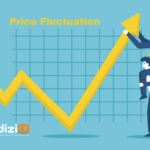Here we will delve into, what are the types of forex market trends with specific examples to understand better.
An uptrend market, also known as a bullish market, refers to the market condition when the price of a currency pair consistently moves higher over time. A series of higher lows (troughs) and higher highs (peaks) characterize an uptrend, preferable that buyers are more commanding and force prices upward.
For example, in the context of the EUR/USD currency pair, if the initial price of the pair starts at 2.2000 and moves from 2.2000 to 2.2500 (first high), then retraces to 2.2200 (first low but it is higher than the initial price) before moving up to 2.2600 (second high), then the second low which will be higher than the first low 2.2400, this pattern is a clear uptrend position.
When the subsequent peak in the prices goes higher than the previous peak it is considered a higher high, demonstrating that buyers are willing to buy at increasingly higher prices of the pair.
When the subsequent trough in the pair price than the previous trough, it is considered a higher low.
C. Positive Market Sentiment:
Positive market sentiment refers to the traders’ and investors’ confidence in the currency pair’s potential to increase in value. Market conditions generally support the bullish outlook such as the economic indicators, geopolitical events, etc.
Understanding the downtrend market, also known as a bearish market is essential in the financial market. It is a condition in which the prices of the currency pair move consistently lower over time. To understand this more clearly in this trend, traders found a pattern of lower highs (peaks) and lower lows (troughs).
Consider the EUR/USD currency pair for example, its initial price starts at 2.2000, and the first low (or the first fall in the price) to 2.1800. Then the first high goes lower than the initial price like 2.1900. The second low will be lower than the first low 2.1600. The price goes lower in the second high than the first at 2.1700. This form of lower highs and lower lows directs an indistinct downtrend market.
Consideration of a downtrend helps the trader to mitigate the losses in the forex market. It can help to maximize profits, market sentiment analysis, risk management, and informed trading decisions.
By utilizing tools such as moving averages, trend lines, and relative strength index (RSI), forex traders can potentially identify and trade within the downtrend markets, and take advantage of the downward motion.
Each peak of the price will be lower than the previous peak, in the downward motion.
Each low in the price will be lower than the previous trough, which will indicate in this position a strong selling interest even during price rallies.
C. Negative Market Sentiment
Usually, negative market outlook, and the investors and traders expect from preferred currency market to keep falling so that they can gain some profit in the negative market.
A sideways trend market referred to as a ranging market, involves the movements of prices in a horizontal direction within a defined range time, with no substantial trend evident. This period of the trend reflects the equilibrium between seller and buyers, in this situation, neither has adequate strength to push the price pointedly lower or higher. The currency price vacillates between formation support and struggle levels, making a horizontal or sideways outline on the market chart.
For instance, in the context of the EUR/USD currency pair, the initial price starts at 2.2000, about this price the first high rises to 2.2500 (higher than the initial price). The first low we can conclude is when the price falls from the initial price of 2.2000 to 2.1800. The second high trend will be the price going higher than the initial price but not more than the first high like 2.2000 to 2.2450. in this scenario, the price constantly changes between the resistance level at 2.2500 and the support level at 2.1800, this indicates the sideways trend of the market trend.
When the price interchanges sideways within the range restricted by the resistance levels and horizontal support, it is considered a horizontal movement in the forex market.
When leading to minimal net price movement and the forces of demand and supply are balanced it will be considered as an equal buying and selling pressure in the market.
C. Indecisive Market Sentiment
Due to the lack of strong trends, where traders and investors are uncertain about the market’s direction, it can be considered as an indecisive market sentiment.
By utilizing the expertise of the market trends traders can predict future market positions, which can make a profitable trade for them. By identifying the currency pair’s trend type, traders can anticipate potential price interchanges. This kind of market prediction forms the source for entering trades at beneficial moves and avoiding trades that go against the dominant trend.
Trends imitate investor psychology and market sentiment.
The uptrend position of the market suggests bullish sentiment and optimism, whereas the downtrend indicates bearish sentiment and caution.
Enhancing trading strategies is very significant in the financial market because successful trading approaches often include trend analysis as a foundational factor in this market. Whether employing riding trends (trend-following strategies) or trading reversals (countertrend strategies), considering market trends allows traders to modify their strategies accordingly.
Trend Analysis in risk management plays a crucial role, traders can utilize trends to place SL (Stop-loss) orders and manage risk efficiently. In case of an uptrend position, placing SL orders below fresh lows can shield against sudden setbacks. And in case of downtrends positions traders can place SL orders above recent highs to mitigate the losses if the trend reverses.
Technical indicators such as trend lines, moving averages, and oscillators including RSI (Relative Strength Index), and MACD (Moving Average Convergence Divergence), depend on trend analysis. These market indicators benefit traders in confirming the trends, generating buy and sell signals, and identifying potential hitches or maintenances. Implementing technical indicators with trend analysis can benefit traders in making more precise and more informed trading decisions.
Multiple tools and techniques can aid traders in analyzing forex market trends, Dizicx’s tools and technical experts host webinars to make these analyses that can work for your trades, which significantly help traders, few we will discuss here in this section of the blog:
The RSI measures the change and speed of the price moment. It arrays from 0 to 100 as well and assists in identifying oversold and overbought market conditions. If the RSI is more than 70 it suggests the overbought situation market while if the RSI is less than 30 it indicates the situation as an oversold market.
MACD is a trend-following momentum indicator of the market that shows the interconnection between moving averages of a security’s price. To make the trading decisions traders look for MACD line crossover and deviations from the currency price.
In this strategy, traders identify and follow the directions of the trend to make profitable trades. They manage their trades as per the trends, if the trend is an uptrend they enter the market for the long term, and if the trend is a downtrend they hold the position for the short term. This strategy involves tools such as moving averages and trend lines, which is crucial.
This is a more advanced strategy, that involves trading against the dominant trend, anticipating a setback. In this strategy, traders need a good knowledge of market conditions and durable risk management practices.
This strategy focuses on categorizing important levels of support and resistance. The minute price breaks through these levels, it directs a probable new trend. Traders can enter these positions in the direction of the breakout, which can be beneficial for them.
This strategy involves entering trades throughout these retracements, targeting to capitalize on the persistence of the trend. Throughout a trend, currency prices often retrace to a certain level before enduring in the trend’s direction.
Make yourself updated with economic news and events that can move currency prices. To be up to date, traders must use economic calendars and news feeds.
To protect your money from loss always use SL Order, it will automatically close the trade position if the market goes against your trade by a certain amount.
Maintain a trading journal so that you can keep track of and analyze your previous trades’ performances. Write down the reasons for entering and exiting trades, and review regularly to learn from your own mistakes.
Patience is very important to be a successful trader, never rush while trading. Wait for clear and strong trend signals before making a trade.
In conclusion, Understanding and turning a profit from forex market trends is a major skill for a trader. By utilizing trend analysis tools and applying effective trading approaches, traders can increase their chances of success in the forex market.

















